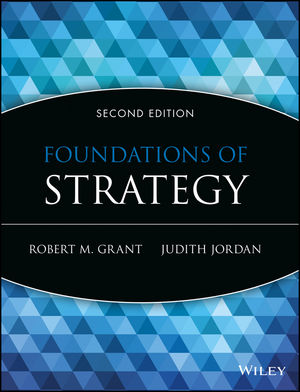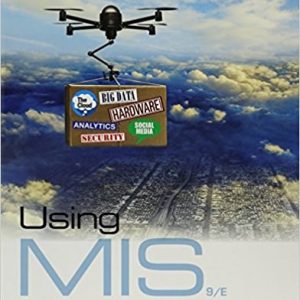This is completed downloadable of Test Bank for Foundations of Strategy, 2nd Edition

Product Details:
- ISBN-10 : 1118914708
- ISBN-13 : 978-1118914700
- Author:
Foundations of Strategy, Second Edition is a concise text aimed at both undergraduate and Masters students. Written in an accessible style with the needs of these students in mind, the second edition of this popular text has a clear, comprehensive approach, underlined by sound theoretical depth. The text has been fully revised and updated to reflect recent developments in the business environment and strategy research.
Extensive learning and teaching materials to accompany this text include aninstructor manual, case teaching notes, test bank and PowerPoint slides are available for instructors. Resources for students include self-test quizzes and glossary flashcards to test understanding.
From the Reviews of the Second Edition …
“This second edition of “Foundations of Strategy” is a concise but comprehensive strategic management textbook for both undergraduate-level and graduate-level students. The book covers some of the most fundamental challenges organizations face as they strive to gain and sustain competitive advantage. The book is full of contemporary case studies that include a balanced mix of theory and application in strategic management. This new edition provides a very useful tools and resources to the increasingly important discipline of strategic management. “ Dr Jay Lee, California State University, Sacramento
“Foundations of Strategy” explains current theory clearly and carefully, with a good range of examples. The quality of my students’ strategic analyses has improved perceptibly since I started using it.” Dr Adrian Haberberg, University of East London
Table of Content:
- 1: The concept of Strategy
- Introduction and objectives
- The role of strategy in success
- A brief history of strategy
- Strategy today
- Strategic management of not-for-profit organizations
- The approach taken in this book
- Summary
- Summary table
- Further reading
- Self-study questions
- Notes
- 2: Industry analysis
- Introduction and objectives
- From environmental analysis to industry analysis
- The determinants of industry profit: Demand and competition
- Analysing industry attractiveness
- Applying industry analysis to forecasting industry profitability
- Using industry analysis to develop strategy
- Defining an industry
- Reviewing the five forces of competition framework
- Segmentation analysis
- Dealing with dynamic competition
- From industry attractiveness to competitive advantage: Identifying key success factors
- Summary
- Summary table
- Further reading
- Self-study questions
- Notes
- 3: Resources and capabilities
- Introduction and objectives
- The role of resources and capabilities in strategy formulation
- Identifying the organization’s resources and capabilities
- Appraising resources and capabilities
- Developing strategy implications
- Summary
- Summary table
- Further reading
- Self-study questions
- Notes
- 4: The nature and sources of competitive advantage
- Introduction and objectives
- How competitive advantage emerges and is sustained
- Types of competitive advantage: Cost and differentiation
- Porter’s generic strategies and being ‘stuck in the middle’
- Summary
- Summary table
- Further reading
- Self-study questions
- Notes
- 5: Industry evolution and strategic change
- Introduction and objectives
- The industry lifecycle
- Managing organizational adaptation and strategic change
- Managing strategic change
- Summary
- Summary table
- Further reading
- Self-study questions
- Notes
- 6: Technology-based industries and the management of innovation
- Introduction and objectives
- Competitive advantage in technology-intensive industries
- Strategies to exploit innovation: How and when to enter
- Competing for standards
- Implementing technology strategies: Creating the conditions for innovation
- Summary
- Summary table
- Further reading
- Self-study questions
- Notes
- 7: Corporate strategy
- Introduction and objectives
- The scope of the firm
- Key concepts for analysing firm scope
- Diversification
- Vertical integration
- Managing the corporate portfolio
- Summary
- Summary table
- Further reading
- Self-study questions
- Notes
- 8: Global strategies and the multinational corporation
- Introduction and objectives
- The implications of international competition for industry analysis
- Analysing competitive advantage in an international context
- The international location of production
- How should firms enter foreign markets?
- Multinational strategies: Global integration vs. national differentiation
- Strategy and organization within the multinational corporation
- Summary
- Summary table
- Further reading
- Self-study questions
- Notes
- 9: Realizing strategy
- Introduction and objectives
- From strategy to execution
- Organizational design: The fundamentals of organizing
- Organizational design: Choosing the right structure
- Organizational culture
- Summary
- Summary table
- Further reading
- Self-study questions
- Notes
- 10: Current trends in strategic management
- Introduction and objectives
- The new environment of business
- New directions in strategic thinking
- Redesigning organizations
- The changing role of managers
- Summary
- Summary table
- Further reading
- Self-study questions
- Notes
- Glossary
- Index
- End User License Agreement





